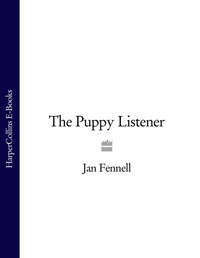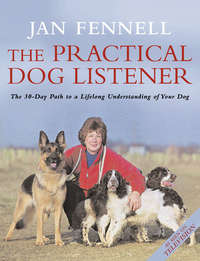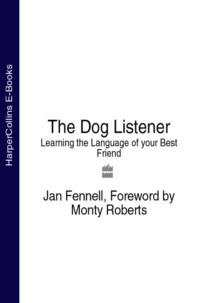
Полная версия
A Dog’s Best Friend

A
DOG’S
BEST FRIEND
The secrets that make gooddog owners great
JAN FENNELL

COPYRIGHT
Harper
An Imprint of HarperCollinsPublishers Ltd
1 London Bridge Street
London SE1 9GF
www.harpercollins.co.uk
First published in Great Britain by HarperCollinsEntertainment 2004
Copyright © Jan Fennell and Fantasma Partnership 2004
The Author asserts the moral right to be identified as the author of this work
All rights reserved under International and Pan-American Copyright Conventions. By payment of the required fees, you have been granted the nonexclusive, non-transferable right to access and read the text of this e-book on screen. No part of this text may be reproduced, transmitted, downloaded, decompiled, reverse engineered, or stored in or introduced into any information storage retrieval system, in any form or by any means, whether electronic or mechanical, now known or hereinafter invented, without the express written permission of HarperCollins e-books.
HarperCollinsPublishers has made every reasonable effort to ensure that any picture content and written content in this ebook has been included or removed in accordance with the contractual and technological constraints in operation at the time of publication
Source ISBN 9780007153725
Ebook Edition © APRIL 2019 ISBN: 9780008363437
Version: 2019-05-13
NOTE TO READERS
This ebook contains the following accessibility features which, if supported by your device, can be accessed via your ereader/accessibility settings:
Change of font size and line height
Change of background and font colours
Change of font
Change justification
Text to speech
Page numbers taken from the following print edition: ISBN 9780007153725
DEDICATION
For my grandchildren
Ceri-Ann, Bethan and Ben
CONTENTS
Cover
Title Page
Copyright
Note to Readers
Dedication
Preface by Monty Roberts
Introduction
‘How Would You Feel?’
Why great owners put themselves in their dog’s place
The Ties That Bind
Why great owners understand man’s special relationship with dogs
‘What’s in it for Me?’
Why great owners work with, not against, their dogs
Our Mutual Friends
Why respect is the key to a great relationship with dogs
Feeling the Force
The importance of drawing on the lessons of others
Living in the Real World
Why great owners know their limits
Role Models
Why great owners lead by example
Second Among Equals
Why great owners always put their dogs first
Flexible Friends
Why great owners keep an open mind
When the Going Gets Tough
Why it pays to show courage under fire
The Great Healer
Why patience really is a virtue
A Dog is for Life
Why great owners understand the meaning of responsibility
99% Preparation
Why great owners think ahead
The Buck Stops Here
Why great owners always shoulder the blame
Happy Families
Why great owners are fun owners
Cometh the Hour
Why great owners rise to the occasion
The Best Dog Comes Home with Us
The importance of owning dogs for the right reasons
Better Happy than Rich
Why great owners understand the real value of dogs
Give a Dog a Good Name
Why great owners don’t pigeonhole their dogs
The Glass Half Full
Why great owners are positive owners
Sense and Sensibility
Why great owners never underestimate their dogs’ instincts
Separate Worlds
Why great owners accept that dogs are different
Letting Go
The importance of knowing when to say goodbye
In Sickness and in Health
When their dogs grow weak, great owners grow strong
Through Thick and Thin
How great owners show strength for their dog’s sake
Reaping the Rewards
Why you only get out what you put in
Breathing Space
The benefits of letting a dog be itself
A Dog’s Best Friend
Why great owners just want to give their dogs the best
Acknowledgements
About the Author
About the Publisher
PREFACE
I can’t remember a time in my life when there wasn’t a dog around and somebody trying to train him to do something. For 65 years or so, I have seen professional dog trainers work, watched amateur dog trainers work and observed as Western rancher-type people as they dealt with their canine assistants. I have seen dogs treated with profound brutality and have witnessed partnerships between dog and human that were as close as one could imagine.
In the early 1950’s, I became acquainted with a man who produced contract dog acts as a part of professional rodeos that were conducted throughout the United States. His name was Jay Sisler and he usually had a gang of border collies with one or two retired racing greyhounds thrown in. I recall that he had a few Australian Shepherds and sometimes an Aussie crossed with a border collie.
Jay Sisler loved his dogs and, probably more importantly, his dogs loved him. I recall times when he would work with a half a dozen dogs or so in one session. I would watch as each dog sat with eyes sparkling and feet prancing in place begging for the opportunity to be the next actor on his stage. Jay specialized in offbeat acts where dogs did things that people just didn’t expect to see.
I remember one night in 1955 when Mr. Sisler turned up at a popular old pub-style restaurant near my university. The proprietor knew about Jay and so allowed him to bring two dogs into the saloon portion of the building. I sat and watched as this man sipped a drink at the bar and then would simply say things in a normal tone of voice that he wanted the dogs to do, and, boy, did they do it!
Watching in utter amazement, I saw these dogs interact with one another and with patrons of the establishment. ‘Blue, go to sleep.’ he would say, and Blue would flatten himself in the middle of the saloon. ‘Freddy, take my jacket and cover Blue up. It’s going to get cold.’ And Freddy would do just that. ‘Now, Freddy, find me a pretty girl. Lead her over to have a drink with me.’ And this dog would circle the room and for all the world it seemed to me that he would pick the most attractive female, gently take her hand in his mouth and lead her to Jay’s side.
They walked tight ropes, sat up on one another’s shoulders, the same as trapeze artists would do. They danced and sang, rode horses, and one would even lead a donkey wherever Jay asked him to go. Sisler loved to create a situation where the Sheppard types would form obstacles over which the greyhound would jump, and those greyhounds could jump the moon. People were consistently left mesmerized by the awesome feats that Jay’s dogs could perform.
For me, it was far more how they did it than what they did. I never saw him strike a dog and I never even heard him raise his voice to one. I don’t know how he did his basic training but looking back on it with two doctorates in behavioural sciences I know how to assess that these dogs did it because they wanted to and because they loved to work with and for this man.
INTRODUCTION
When my book The Dog Listener was first published, I had no idea it would connect with such a wide audience. It is a source of constant pride to me that so many people have turned to the compassionate communication method advocated in its pages. By rejecting the aggressive and damaging ideas of the past, they have displayed the open-mindedness and, I like to think, intelligence that instantly separates the good owner from the bad one. They have made an important first step.
Perhaps the greatest lesson I have learned since the publication of that book (and its sequel, The Practical Dog Listener) is that people’s desire to improve the quality of the life they share with their dogs is limitless. The world, it seems, is full of owners dedicated to becoming the companions their dogs really deserve. I am always meeting people eager to deepen their knowledge still further, to develop into not just good owners but great ones.
But what is it that makes a great owner? What are the qualities that distinguish these people from the rest? These are questions that I’m asked all the time and, if I’m honest, have often struggled to answer – to my own satisfaction at least.
I have met all kinds of owners in the course of my life and career. A few have been awful, unfit even to own a dog in my opinion, but most have been good, caring people, genuinely interested in making their dog’s life a happy one. Along the way, it has been my good fortune to have met people whose characters and abilities have elevated them above the rest, owners who have made a lasting impact on me, and about whom I’d use the word ‘great’ without hesitation.
It was while thinking about some of these people recently that the idea for this book was born. I had been asked for the umpteenth time what it is that makes a great owner, what separates them from the rest, when suddenly it occurred to me that if there is a simple answer to that question, then these exceptional people would be able to provide it. It struck me that if I shared their stories, explaining what they taught me and, in so doing, highlighting their strengths and qualities, then I might go a long way towards defining the kind of outstanding ownership to which so many people aspire.
It wasn’t long before I was drawing together memories of individuals who have impressed me, not only as owners and people but also as independent thinkers. As I moved on to analyse what it was each of them gave me, so this book took shape.
The owners who feature in these pages are a diverse bunch. Some are family members who sowed important seeds in my younger life, others are people who played a pivotal role in leading me to develop my method. Some have inspired me by example, others have helped me develop my methods or sharpen my thinking since I took my work out into the wider world. One or two have simply made me appreciate just how deep the well of human kindness runs when it comes to dogs.
Yet, for all their differences, they share one thing in common. Each of them has – or had – a special bond with man’s best friend. And each passed on to me something valuable about the way we live with dogs. By absorbing their lessons, I hope everyone can take that next step and become not just a good owner, but a great one.
Jan Fennell
North Lincolnshire, Spring 2004

‘HOW WOULD YOU FEEL?’
Why great owners put themselves in their dog’s place
Our attitude to dogs – and to the animal world in general – has gone through enormous changes in my lifetime. During my childhood in post-war London, most people would have treated the modern notion of animal rights and welfare with disdain. It would have brought me little but ridicule to espouse in public the sort of compassionate training ideas I do now.
Yet, even fifty or so years ago, these seemingly modern ideas were already alive and blossoming in places. I was lucky enough to grow up within a family who viewed our relationship with animals – and dogs in particular – in a way that was unusual for the time. Ours was a family of horse and dog lovers, and no one had a deeper affinity for both than my great-uncle Jim.

Uncle Jim was in his eighties when I was a little girl but was still a remarkable character. His colourful life included a spell with Buffalo Bill Cody’s world-famous Wild West Show, an experience that had provided him with an unusual attitude to animals. I remember him telling me about the time he spent with the troupe’s Native Americans. Their empathy with the show’s horses had a deep impact on him, so much so that he had an almost telepathic relationship with Kitty, the lovely little black pony which pulled his vegetable cart around the streets of Fulham, Hammersmith and West London in the 1950s.
Some of my earliest and warmest childhood memories are of Uncle Jim, laying down the reins, putting his arms around me and gently whispering, ‘Take us home, Kit.’ Sure enough, Kitty would pick her way through the streets, like a homing pigeon.
Looking back on it now, it was Uncle Jim and Kitty who first instilled in me the idea of animals and humans working together in harmony. Uncle Jim used to talk about the way his Native American colleagues told him to ‘breathe with the horse’. He and Kitty worked instinctively as a team. There was no coercion – they understood each other perfectly – and, as a result, their partnership seemed like the most natural thing in the world.
As a little girl I used to spend long hours sitting on the pony and trap with Uncle Jim. I saw many things that captured my imagination, but nothing quite so thought-provoking as what I witnessed outside, of all places, a pub one lunchtime.
Uncle Jim and his fellow street vendors lent real character to their area of London. They were a colourful collection of individuals, each on their pony and trap, clattering through the streets, living by a code that went back to an earlier age. One of their traditions was to meet up at various watering holes. It wasn’t hard to spot where they were gathered – neatly arranged ranks of horses and carts would form outside.
Jim and his friends would put nosebags and blankets on their horses, then pop inside for a couple of hard-earned pints. If I was with Jim, he’d always get me a glass of lemonade and a packet of crisps to eat out on the cart. I was quite happy there, particularly when a friend of Jim – a rag-and-bone man called Albie – left me in the company of his dog Danny.
Albie was famous for travelling everywhere with Danny. As most dogs were at that time, Danny was a crossbreed, or ‘multi-pedigree’ as I like to call them now. He would sit upright at Albie’s side, as if he was his eyes and ears, which given his master’s advancing years, sometimes he probably was.
One lunchtime, Albie and Jim arrived at the pub and were tending to their horses. Danny, as usual, had been put up on the trap with me.
Albie was very affectionate towards Danny, unusually so for the time. ‘You stay there now, there’s a good boy,’ he told his dog, ruffling his neck as he placed him on the seat next to me.
As Albie was doing this, another rag-and-bone man had pulled up alongside.
He had seen Albie talking to his dog like this and was shaking his head, as if in disbelief.
‘What the hell are you talking to the mutt for?’ he said, barely able to suppress a laugh. ‘You don’t ask a dog to do something. You tell him.’
Albie didn’t take too kindly to this.
‘Is that right?’ he said. ‘So how do you expect good manners if you don’t show good manners?’
The other man looked nonplussed.
‘What are you on about?’ he said.
Albie indicated to me. ‘If I wanted young Janice here to do something, what do you think would be the best way to get her to do it? Ask her nicely or show her the back of my hand?’
The other man simply shook his head, as if to say Albie was soft in the head. They soon disappeared into the pub, where – presumably – the argument carried on.
On the surface this may seem a small moment, nothing much to write home about. But to me, at the age of five or six, it struck a powerful chord.
The London of those days was a difficult place to make a living. We were still getting over the effects of the Second World War – my mother and father had found it particularly hard to readjust to life after their wartime experiences. And life was generally hard at that time, so the notion that dogs were deserving of anyone’s time and effort was highly unusual. ‘It’s just a dog,’ was a commonplace expression. Yet here was someone defending a dog as if it were a person. It was something I had never heard before, but I soon discovered it wasn’t a unique view.

Another influential person in my childhood was my cousin Doreen. While I was younger, Doreen lived near us in West London with her family, but when I was ten or so, she moved to Welwyn Garden City, the utopian new community in Hertfordshire. We regularly visited them there, on Sundays, Bank Holidays and Christmas.
The move to the greener climes of Hertfordshire had an immediate impact on the family’s lifestyle. It wasn’t long before I discovered they had acquired a dog – a lovely, black and tan crossbreed puppy they named Tinker. Tinker belonged to the whole family, but early on it was clear that Doreen regarded him very much as her dog. Most of the time it was she who fed him and walked him. And she spent the most time playing with him.
He was not the first dog in the family – that was Bruce, a lovely white German shepherd one of my uncles had got from Battersea Dogs Home. The mistreatment he suffered still haunts me to this day. I will never forget the way my uncle would tease him by placing a bar of chocolate high on a table, leaving Bruce to salivate as he looked at it. From the outset, however, it was clear that Doreen had a very different attitude to dogs.
Their house was always full of people. The first time I went there my cousin Paul was playing with a friend. I remember they were in the garden throwing a ball around. As part of their entertainment they put the ball in front of Tinker’s face, then pulled it away again as he snapped to grab it. Paul had only done this a couple of times when Doreen appeared in the kitchen doorway. By coincidence, she happened to have a rolling pin in her hand. It made the sight of her all the more intimidating.
‘You can stop that right away, young man. I won’t have that,’ she said. ‘How would you like it if someone did that to you?’
The boy looked stunned, as I must have done. I had never heard anyone in the family defend a dog in that way before. But it wasn’t long before I heard it again.
A little later that same day, Doreen’s husband, Reg, appeared in the garden with a biscuit. Reg was fond of Tinker and would take him for walks, and the dog soon appeared at his side. ‘What’s the matter? Want a bit of this do you?’ he said playfully waving the biscuit around.
Doreen soon reappeared – this time without the rolling pin. He may have been the ‘man of the house’, but the same rules applied.
‘Reg, I won’t have you teasing him like that. It might be fun for you, but it’s not fun for the dog. How’d you like it?’
We all laughed, but I looked at Doreen’s face and saw she was utterly serious. From then on, I became fascinated by her relationship with her dog.
Doreen was a wonderful person and I always looked forward to seeing her, but the fact she had such a lovely dog made each visit even more special. Doreen was very strict about what we could and couldn’t do with her dog. Playing the retrieval games which Tinker enjoyed was fine. Taking him out for a walk without an adult, on the other hand, was not. ‘You’re not responsible enough to take a dog out,’ she said, which again was something new and radical for me. Back in the streets of West London, children routinely walked dogs.
Doreen was absolutely consistent in her approach, no matter who was involved. On one occasion, I remember my father and his brother, Doreen’s father, Fred, playing ‘piggy in the middle’ with a ball and Tinker as the increasingly agitated ‘piggy’. Doreen was upstairs, but the moment Tinker let out a distressed bark, she was bounding down the stairs.
‘What do you think you’re doing?’ she asked them – it didn’t matter that it was her father and uncle involved, two of the senior figures in the family.
My Dad put an arm around her and asked her to lighten up a little.
‘Come on, Doreen, you think more of that dog than you do of us,’ he said.
But she was adamant. ‘He’s my dog and I’m going to treat him my way and I’m not having it, Uncle Wal.’ And that was that.
On another occasion, her daughter Diane was trying to put a doll’s bonnet on Tinker. Again there was no argument.
‘Stop that, you have dolls for that,’ Doreen insisted. ‘The dog is not there for your entertainment.’
Looking back, I can see that Doreen’s approach worked. As Tinker grew up, I couldn’t help noticing how much calmer he was than all the other dogs I’d come across. There was no rushing around, no barking and jumping up. I remember asking her one day, ‘How come Tinker’s so happy, Doreen?’
‘Because I haven’t made him mixed up like so many other people do,’ she said. ‘Other people’s dogs are so anxious all the time. No wonder, given the way people tease them and treat them badly. All I do is give some consideration to how he’s feeling.’
It was an attitude that was an extension of Doreen herself. She was the warmest, kindest person in my family. She was also someone who committed herself one hundred per cent to anything she did. To everybody else, ‘a dog was just a dog’. But to Doreen it was a living creature, with feelings, with a soul.
As Tinker’s training developed, so too did Doreen’s ideas. She used food rewards in a way I’d never seen anyone do before. For instance: ‘Tinker’s not going to do the right thing for nothing,’ she’d say. ‘He’s not stupid.’
My Uncle Fred would often see this and tell her she was spoiling him and turning him into a softie. ‘The dog should do it because you say so,’ he’d say.
She’d shoot him a look and reply: ‘You wouldn’t.’
As a young girl, sitting there on the fringes of all this, I remember thinking what common sense it sounded. But it was a long time before I understood what Albie and Doreen had instinctively sensed: that a dog was going to respond better if it was shown some respect and consideration, that you were going to have a better relationship by empathising with it, by trying to understand how it might feel to be in its position. It was a lesson worth waiting to learn.








